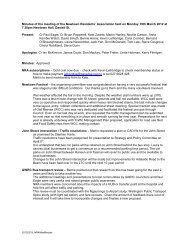Draft Town Belt Management Plan - Wellington City Council
Draft Town Belt Management Plan - Wellington City Council
Draft Town Belt Management Plan - Wellington City Council
Create successful ePaper yourself
Turn your PDF publications into a flip-book with our unique Google optimized e-Paper software.
5. Citizen action<br />
The <strong>Town</strong> <strong>Belt</strong> has attracted ardent citizen involvement over its history. A ‘hands off the <strong>Town</strong> <strong>Belt</strong>’<br />
lobby has regularly spoken out against the misuse and diminution of the <strong>Town</strong> <strong>Belt</strong>, positioning<br />
itself as the defender of a threatened public good. Many of the same groups and individuals have<br />
put their energies into practical ‘hands on’ beautification projects.<br />
Community advocacy for the <strong>Town</strong> <strong>Belt</strong> started as early as 1842 with letters to the editor and<br />
developed around the early 1880s, perhaps spurred by the realisation of what had been already lost<br />
– the <strong>Town</strong> <strong>Belt</strong> was already substantially diminished and denuded when it was transferred to the<br />
<strong>Council</strong> in 1873. Perhaps, too, citizens felt more able to influence <strong>Town</strong> <strong>Belt</strong> management once it<br />
was in local government hands.<br />
Several groups, in particular, have featured as <strong>Town</strong> <strong>Belt</strong> advocates:<br />
In the mid-1890s, the Scenery Preservation Society was formed to beautify the city. It carried out a<br />
number of reserve planting projects, including several on the <strong>Town</strong> <strong>Belt</strong>, raising money to fund the<br />
plant purchases and to employ a gardener to look after the plantings.<br />
The <strong>Wellington</strong> Beautifying Society was strong during the 1930s to 1960s. It too, was involved with<br />
tree planting to enhance the condition of the <strong>Town</strong> <strong>Belt</strong>, which it described in 1952 “as a disgrace<br />
to citizens” 131 . It was also vocal in its protests against alienations from the <strong>Town</strong> <strong>Belt</strong>, which it<br />
described as a “breathing space” 132 passed on from <strong>Wellington</strong>’s forefathers.<br />
Action for Environment became active in the 1970s. It not only undertook planting projects aimed<br />
at restoring native forest on the <strong>Town</strong> <strong>Belt</strong> but was also proactive in its advocacy, writing regularly<br />
to the <strong>Council</strong> asking for information about <strong>Town</strong> <strong>Belt</strong> management and suggesting policies for<br />
better protection and enhancement. It was active in promoting the establishment of the Open<br />
Space C zoning in the District <strong>Plan</strong>. Forty years on, it is still active, most recently having appealed<br />
an Environment Court decision to allow an extension of the <strong>Wellington</strong> Badminton Association’s<br />
hall on <strong>Town</strong> <strong>Belt</strong> land.<br />
The Friends of the <strong>Wellington</strong> <strong>Town</strong> <strong>Belt</strong> group was established in 1995 (in accordance with the<br />
<strong>Town</strong> <strong>Belt</strong> <strong>Management</strong> plan 1995) “to safeguard the <strong>Town</strong> <strong>Belt</strong> as a place of visual beauty and<br />
public recreation, and to assist in its management” 133 . It has made regular submissions on <strong>Town</strong><br />
<strong>Belt</strong> issues, disseminated information about the <strong>Town</strong> <strong>Belt</strong> and assisted with funding <strong>Town</strong> <strong>Belt</strong><br />
projects, including the preparation of the Te Ahumairangi Hill Landscape <strong>Plan</strong>.<br />
Other groups that have been involved with <strong>Town</strong> <strong>Belt</strong> issues or projects at various times over the<br />
decades have included progressive associations, residents associations, historic societies, sports<br />
and other user groups, environmental groups, rotary and lions clubs and gardening groups.<br />
Hands off the <strong>Town</strong> <strong>Belt</strong><br />
‘Hands off the <strong>Town</strong> <strong>Belt</strong>’ became the rallying call among those who lobbied to protect the <strong>Town</strong><br />
<strong>Belt</strong>. For them, the <strong>Town</strong> <strong>Belt</strong> was a sacrosanct open space that was held in trust for all and<br />
provided a valuable public good. Other interests perceived it as an under-used wasteland that<br />
would be better put to other use. Controversy and public debate between the opposing viewpoints<br />
has flared at intervals.<br />
As early as 1882, a <strong>Council</strong> proposal to build an old men’s home on five acres of <strong>Town</strong> <strong>Belt</strong> met with<br />
opposition and was abandoned. The New Zealand Times entered into the debate, declaring that,<br />
131 “Beautifying Society Dislikes Encroachments on <strong>Town</strong> <strong>Belt</strong>,” Evening Post, 4 June 1952.<br />
132 Ibid<br />
133 http://www.townbelt.wellington.net.nz/about_town_belt.html, 21 June 2012.<br />
226<br />
<strong>Draft</strong> <strong>Town</strong> <strong>Belt</strong> <strong>Management</strong> <strong>Plan</strong> October 2012





